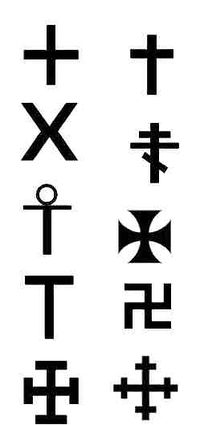Cross
A symbol of great antiquity which predates Christianity by several millennia. Its form has many variants, such as the decussated cross or “X,” the ansated cross with a circle on top, the swastica, the Jainian cross, and others.
One of the earliest forms of the cross is the Egyptian ankh, which is a cross with a handle or circle on top. It is found in the hands of Egyptian representations of their gods, as well as those of Baal and the Phoenician Astarte. The cross is also found in the hammer of Thor in Scandinavian mythology, and later appears as the Masonic mallet.
Most probably the generally accepted interpretation of the cross is that it represents a binary system: the horizontal limb corresponding to the passive principle or the world of phenomena and the vertical limb the active principle, that is, the transcendent world of spiritual evolution. But long before it was adopted as a symbol of Christianity, “the sign of the cross was used as a sign of recognition among adepts and neophytes, the latter being called Chrests (from Chrestos, man of tribulation and sorrow)” (SD II:562).
Theosophically viewed, the Christian cross has, in two dimensions, vertical and horizontal lines with a point of intersection. The vertical pole is štma, or “spirit” and here descends the life of the Monad which is the highest aspect of the individual, thus forming the vertical shaft of the cross. The human constitution is made up of seven principles which are always present, no matter what the degree of development prevailing. Certain of these principles are active and some passive or subjective, the condition depending on the spiritual level attained. For the vast majority of humanity most of the principles are only partly awakened and at the particular level the condition is symbolized by the horizontal arm of the cross. Below the arm we find the spiritual levels that the individual has gained during the past lives.
The horizontal arm divides the objective “field” from the “subjective” in one of its functions, but may on the other hand, unite them; both are true since the horizontal is a moveable bridge.
It has been suggested by some theosophical writers that the cross is the symbol of the manifested life of the Logos through the higher and lower natures of the human with the Divine Ray passing through the lower quaternary or personality. Here the reference is to the fact that a cross may be considered to be made up of four parts.
It is worth noting that Origen, an early Christian Father, taught that the best attitude for prayer is to stand with arms outstretched, so forming a cross (K. C. Anderson, Cradle of the Christ).
P.S.H.
© Copyright by the Theosophical Publishing House, Manila
